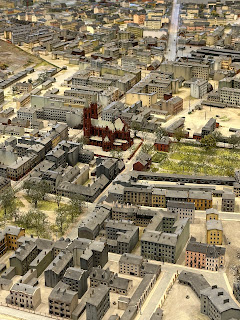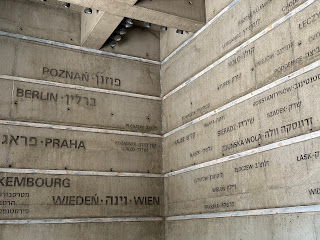The Polish alphabet has symbols that they add to a letter and letter combinations that completely change their pronunciation, and Lodz is one of these. In Polish it looks like this: Łódź.
The line through the L makes the sound "w" and the "dz" makes the sound of "j." It is pronounced as wuj. I am still practicing, but it's still much easier to say than Szczebzreszyn.
We do not have a family connection to Łódź , Poland's third largest city, but it was an interesting place to stop on the long trip between Warsaw and Krakow. After watching the movie, Treasure, I was glad that the city was on our itinerary. Our travel agency made arrangements for a Jewish tour of Łódź, and our guide, Adam, is an expert in Jewish Łódź , although like many of our guide of Jewish history, is not Jewish himself. However, he has written several books and is partly responsible for the Łódź Ghetto museum and many of the tourist signs around the city.
The Łódź ghetto, Litzmannstadt Ghetto, was the second largest after Warsaw. The museum, Sladami Getta Łódźkiego in Polish, is situated at the Radogoszcz Station, the site from which people were transported out of the ghetto to concentration and death camps.
Łódź Ghetto Museum
This is not a chimney, but a sewer tube from the original train station.
Our guide, Adam, explaining the layout of the ghetto.
There is a complete model of the ghetto created by Adam Sitarek and his team.
Radegast Train Station
This is an original locomotive that was used to transport Jews from elsewhere to the ghetto.
A memorial to the towns from which Jews were transported to the Łódź Ghetto
Our next stop on our tour of Jewish Łódź was the Jewish cemetery which was established in 1892 and remains an active cemetery, containing around 200,000 graves. There are no mass graves here. Jews who died in the ghetto were given individual burials, although no matzevot (headstone in Hebrew) were erected. Not all of the tombstones were left unscathed. Some broken ones were made into a wall, and before you cross under the gates of the cemetery there is the remains of a matzevah that was made into a blade sharpening stone.
Matzevot turned into a blade sharpening stone
Entrance to the Łódź Jewish cemetery
The entrance to the funeral chapel
The funeral chapel is in need of renovation, although it contains several examples of funereal
items such as a wagon and cleaning table for the bodies.
The stained-glass windows were replaced in a previous renovation.
Funeral wagon
In addition to the chapel and gravesites of over a century of Jewish people, the cemetery has several memorials. This one is to the victims of the Holocaust. Notice the broken tree but new life springs from it on the right.
Holocaust Memorial
Matzevah for a well-known rabbi. Note the torah scrolls
One of the richest Jews in the city, Izrael Poznanski owned the textile factory and was in competition with another Jewish tradesman for the most elaborate mausoleum, creating a memorial to himself that includes a gilded ceiling. His factory is now a center of restaurants, shops, and entertainment while his home. the Izrael Poznanski Palace, is now the Museum of the City of Łódź. The site of his "palace" was originally a tenement building that he had transformed into a Neo-Renaissance and Neo-Baroque residence (1888-1903).
Izrael Poznanski's Mausoleum
Gilded ceiling of the mausoleum
Poznanski's daughter's grave outside the family mausoleum
Survivor's Park (Park Ocalalych in Polish) is a celebration of life for those who survived the Holocaust. Similar to the Path of the Righteous Gentiles at Yad Vashem, a tree is planted in honor of each individual with a path of stones identifying each by number. The park was opened on the 60th anniversary of the liquidation of the Łódź Ghetto in August 2004. The idea of the park was generated by Halina Elczewska who survived Auschwitz and Ravensbruck in addition to the ghetto. She was the first person to plant her "tree of memory." Today there are over 400 trees that include pines, spruces, larches, lindens, oaks, and maples. Rather than plant them in an organized manner, as first intended, Halina suggested they be planted all over the park in a random pattern to signify rebirth across the land of what was at one time the ghetto.
Survivor's Park
Survivor Stones that correlate to the numbered "trees of memory"
A section of the park is dedicated to the Righteous Gentiles who assisted the Jews. Jan Karski was a Polish soldier and resistance fighter and diplomat during World War II. He helped spread the word about the Nazi's Final Solution, including the liquidation of the Warsaw Ghetto and the operation of death camps in Poland.
A statue of Jan Karski sits in top of the Memorial Mound overlooking the park.
The tree symbolizes rebirth and life
The Statue of Moses and the Ten Commandments outside of the park. Some Jews were not happy with the statue since the tablets do not contain the ten commandments themselves, but, in the end, they were glad to see the commemoration to the survivors and no other action was taken.
























No comments:
Post a Comment